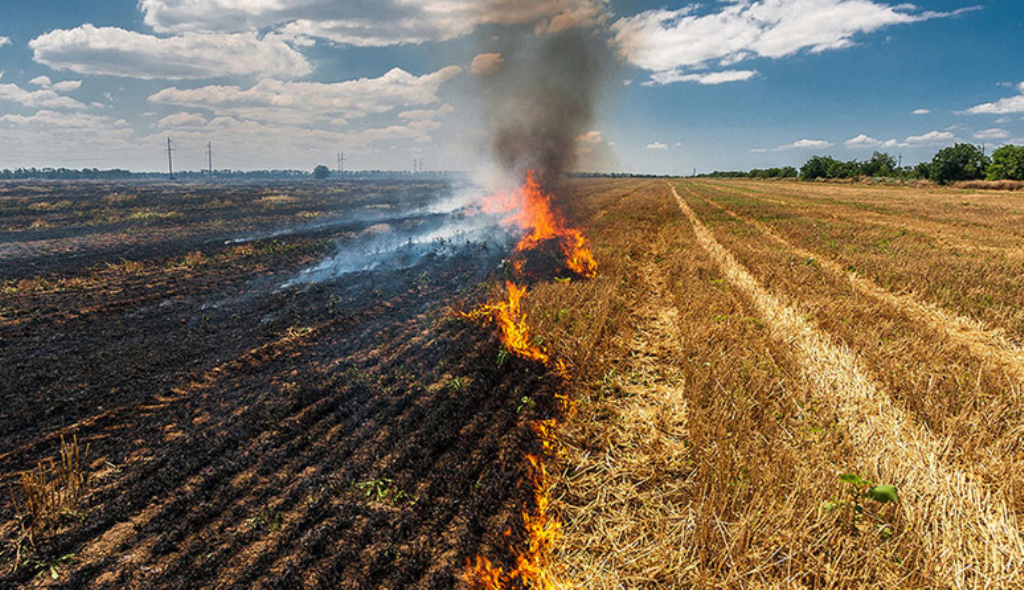
Introduction
Crop Residue Burning (CRB) or Burning of agricultural biomass residue has been identified as a major health hazard. Burning crop residue causes remarkable pollution problems in the atmosphere and huge nutritional loss and physical health deterioration to the soil. The burning of one tonne of paddy straw releases 3 kg particulate matter 60 kg CO, 2 kg SO2 and 199 kg ash. These gases affect human health due to general degradation in air quality resulting in aggravation of eye and skin diseases, and very fine particles can also cause chronic heart and lung diseases. The composition of nutrients in crop residue is highly rich, like one ton of paddy straw contains approximately 2.3 kg P2O5, 5.5 kg N, 25 kg K2O, 1.2 kg S, 50-70% of micro-nutrients absorbed by rice and 400 kg of carbon, which are lost due to burning of paddy straw only. India is an annual gross crop residue producer of 371 million tons (mt), of which paddy and wheat residues constitutes 51– 57% and 27–36% respectively. Apart from loss of nutrients, some of the soil properties like soil temperature, pH, moisture, available phosphorus and soil organic matter are greatly affected due to burning in the fields.
The major impact of crop residue burning are
(a) Emission of green house gases and soot particles
(b) loss of plant nutrients and biodiversity
(c) mortality of active beneficial soil bacteria
(d) loss of soil nutrients and fertility
(e) loss of flora and fauna
(f) soil hardening and erosion due to no cover.
Causes of crop residue burning
The main causes of crop residue burning is the time available between the rice harvesting and wheat sowing is very narrow and in the range of 20-30 days at the end of the Kharif season. Paddy is a water-intensive crop and the high usage of water in its cultivation paddy cultivation can legally begin only around mid-June, when the monsoons typically arrive over North India. During harvesting of paddy crop, the large units of harvesters leave 6-10 cm of paddy stalk on the field and the removal of the paddy stalk that remains in the field is a labour-intensive process. The rise in labour cost and the subsequent costly availability of mechanical implements in Punjab and Haryana lead to about 85-90 per cent of the paddy straw is burnt in the field. The Government of India took several step towards banning crop residue burning in the fields. Crop residue burning was notified as an offence under the Air Act of 1981, the Code of Criminal Procedure, 1973 and various appropriate Acts. In terms of efforts being made to reduce crop residue burning, the various approaches have been used by various state and central administrations and regulatory bodies. National Green Tribunal (NGT), funds have been released from within the sanctioned budget for Sub Mission on Agricultural Mechanization (SMAM) which is implemented on 60:40 sharing pattern between Centre and State.

In the Budget 2018, announcement regarding a special Scheme on ‘Promotion of Agricultural Mechanization for In-Situ Management of Crop Residue in the States of Punjab, Haryana, Uttar Pradesh and NCT of Delhi’ for the period from 2018-19 to 2019-20 has been approved. The scheme will be implemented in Punjab, Haryana, Uttar Pradesh and NCT of Delhi, to promote the usage equipment and machines for in-situ management of crop residue. Objective of the Scheme is to protect environment from air pollution and preventing loss of nutrients and soil micro-organisms caused by burning of crop residue. Haryana State Pollution Control Board (HSPCB) has also taken various measures to limit the amount of agricultural pollution in the state such as in 2016–17, Haryana Government commenced action against 1406 violators. However, after a lot of efforts, thing are not up to the mark and requires detection and prevention, establishment of a market place for crop residue burning, outreach and public awareness campaigns, subsidy on agri-implements, crop diversification, creation of a market for paddy straw and utilisation of paddy straw in the form of biomass pellet fuel. It is envisaged that appropriate strategies for in situ crop residue management are planned for effective implementation to enable zero burning.
The example where the effective implementation to enable zero crop residue burning is practiced at ICAR-CSSRI, Karnal. ICAR-Central Soil Salinity Research Institute, Karnal together with village Panchayat, Begampur, came forward to have participatory diagnosis of salt affected community lands. Based on the soil diagnosis data, the scientists from ICAR-CSSRI shared the knowledge with other investors on deficiency of soil nutrients and SOC of community lands caused by farmers’ practice of burning of full residue of rice crop and about 30.0% residue of wheat crop. These soils were low in nitrogen (100.0%), boron (86.7%), zinc (66.7%), iron (33.3%), manganese (93.3%) and soil organic carbon (SOC) (73.33%). To enhance the adaptive capacity of such agro-ecosystem due to burning of crop residue in fields, soil is deficient in nutrients and high soil pH is corrected by applied the accurate amount of gypsum into soil having high pH (e.g., 8.0 to 8.5 t/ha to neutralize pH 2, 8.4 to 9.6) along with integration of above stated agro-practices, may increase rice and wheat yields upt o 15-20 per cent.
The field crops remain is a great natural resource of nutrients to soil structure and fertility. The use of crop residues as an option to feed animals, nutritional added value compost, and mushroom cultivation and spawning bio-energy for rural supply. However, various machines such as Super Straw Management System (SMS) attached with existing combine harvester, Happy Seeder, Straw Chopper / Mulcher, Rotary Slasher, Reversible M B Plough, Rotavator etc. The benefits of retention of crop remains on soil surface are improves physical, chemical and biological attributes of soils, saves weedicide cost due to lesser weed growth, and recycling of plant nutrients and lowering fertilizer use in the next successive crops. The crop remains also helps in increased cation exchange capacity (CEC), increase in microbial biomass, enhanced enzymes activities such as alkaline phosphatase and dehydrogenase.
Following suggestions are required to maintain good crop residue management practices:
-
Targeting crop residue to produce renewable energy for upgrading of air, soil quality, mitigating climate change effects and global warming.
-
Crop residues should be categorized as recycling i.e. lime or gypsum and their use in agriculture field like any other mineral fertilizers.
-
To utilize the surplus crop residue for energy generation by establishment of energy plants.
-
In-situ management practices in the field, fast decomposition by chemical or biological means and straw mulching by mechanical means must be promoted.
-
The machines like use of zero tillage, double disc coulters, and happy seeder would help in mulching the crop stubble.
-
Paddy residue could be collected and may be used for generating useful products viz. organic manure, making compost and bio-char to improve soil health or fertility and gasification as an alternate fuel for power generation.
-
Change in the harvesting method of paddy crop and the crop stem may be cut from the root level itself with the help of suitable reaper cum harvester that should be developed using indigenous techniques.
-
Establish provision of encouragements to farmers for not burns paddy residues in the open.
Crop residues can be used as feed for livestock, raw materials for industry and fuel. Management problems of crop residues remains diverse in different regions like in some regions crop residues is burns due to lack of proper education to farmers and however, in other places everyone are aware of the adverse effects of paddy straw burning at the farm level but they are constrained by the lack of acceptable machineries, economically viable and alternatives for disposal of paddy residues. Government should promote and provide need based support alternative options to stop residue burning instead of strict law enforcements to minimize its implications on soil, human and animal health.
References
- (ICAR-Central Soil Salinity Research Institute, Karnal)https://icar.org.in/content/resolution-zero-crop-residue-burning-and-evolving-community-based-management-sodic.
- Shiv Kumar Lohana, H.S. Jatb, Arvind Kumar Yadavc, H.S. Sidhud, M.L. Jatb, Madhu Choudharyc, Jyotsna Kiran Petere, P.C. Sharmac, Burning issues of paddy residue management in north-west states of India, Renewable and Sustainable Energy Reviews, August 2017.
- https://www.downtoearth.org.in/news/air/crop-burning-punjab-haryana-s-killer-fields-55960
- National Policy for Management of Crop Residues (NPMCR) 2014
Authors:
Kapil Deshwal (Ph. Scholar, RPCAU)
Dr. Shailesh Kumar (Assistant Professor, CBS&H, RPCAU, Pusa, Bihar-848125, India
Dr. A K Singh (Professor, CBS&H, RPCAU, Pusa)
Dr. Sweta Mishra (Associate Professor, COB, SVPUA&T, Meeurt-250110)












Share your comments